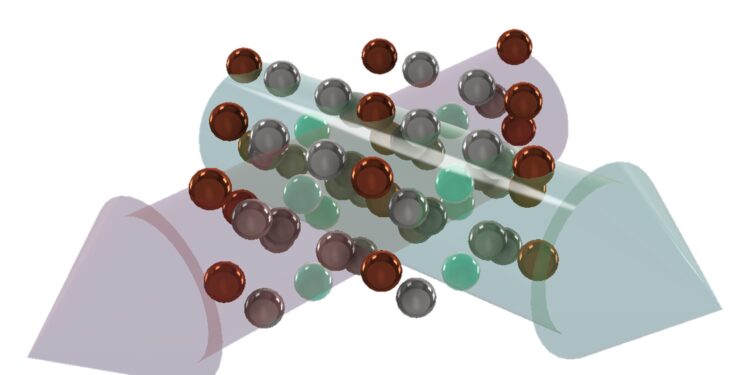The direction of an electron’s spin is determined by the direction of electron motion. Credit: Hans-Joachim Elmers / JGU
Ferromagnetism and antiferromagnetism have long been known by scientists as two classes of magnetic order of materials. In 2019, researchers at the Johannes Gutenberg University Mainz (JGU) postulated a third class of magnetism, called altermagnetism. This altermagnetism has since been the subject of heated debate among experts, with some expressing doubts about its existence.
Recently, a team of experimental researchers led by Professor Hans-Joachim Elmers from the JGU was able to measure for the first time at DESY (Deutsches Elektronen-Synchrotron) an effect considered to be a signature of altermagnetism, thus providing proof of the existence of this third type of magnetism. The research results were published in Scientists progress.
Altermagnetism: A new magnetic phase
While ferromagnets, which we all know from refrigerator magnets, have all their magnetic moments aligned in the same direction, antiferromagnets have alternating magnetic moments. So, on a macroscopic level, the magnetic moments of antiferromagnets cancel out, so there is no external magnetic field, which would simply cause refrigerator magnets made from this material to fall off the refrigerator door.
The magnetic moments in altermagnets differ in the way they are oriented. “Alternagnets combine the advantages of ferromagnets and antiferromagnets. Their neighboring magnetic moments are always antiparallel to each other, as in antiferromagnets, therefore there is no macroscopic magnetic effect, but, at the same time, they exhibit a spin-polarized current, just like ferromagnets,” explained Professor Hans-Joachim Elmers, head of the Magnetism group at the Institute of Physics at JGU.
Move in the same direction with uniform rotation
Electric currents generally generate magnetic fields. However, if we consider an altermagnet as a whole, integrating the spin polarization in the electronic bands in all directions, it becomes obvious that the magnetic field must be zero despite the spin polarized current. If, on the other hand, attention is limited to electrons moving in a particular direction, the conclusion is that they must have uniform spin.
“This alignment phenomenon has nothing to do with the spatial arrangement or location of the electrons, but only with the direction of the electron velocity,” Elmers added. Since velocity (v) times mass (M) equals momentum (P), physicists use the term “momentum space” in this context. This effect was predicted in the past by JGU theoretical groups led by Professor Jairo Sinova and Dr. Libor Šmejkal.
Evidence obtained by pulse electron microscopy
“Our team was the first to experimentally verify this effect,” Elmers said. The researchers used a specially adapted pulse microscope. For their experiment, the team exposed a thin layer of ruthenium dioxide to X-rays. The resulting excitation of the electrons was sufficient for their emission from the ruthenium dioxide layer and detection.
Based on the velocity distribution, the researchers were able to determine the speed of electrons in ruthenium dioxide. And using circularly polarized X-rays, they were even able to deduce the rotation directions.
For their pulse microscope, the researchers modified the focal plane normally used for observation in standard electron microscopes. Instead of a magnified image of the surface of the ruthenium oxide film, their detector showed a representation of momentum space.
“Different pulses appear at different positions on the detector. In simpler terms, the different directions in which electrons move in a layer are represented by corresponding points on the detector,” Elmers said.
Altermagnetism may also be relevant to spintronics. This would involve using the magnetic moment of electrons instead of their charge in a dynamic RAM. The storage capacity could thus be considerably increased.
“Our results could provide the solution to what is a major challenge in the field of spintronics,” Elmers suggested. “Harnessing the potential of alter-magnets would make it easier to read information stored based on spin polarization in electronic bands.”
More information:
Olena Fedchenko et al, Observation of symmetry breaking by time reversal in the band structure of altermagnetic RuO 2, Scientists progress (2024). DOI: 10.1126/sciadv.adj4883
Provided by Johannes Gutenberg University Mainz
Quote: Altermagnetism demonstrated experimentally (February 15, 2024) retrieved on February 15, 2024 from
This document is subject to copyright. Apart from fair use for private study or research purposes, no part may be reproduced without written permission. The content is provided for information only.



